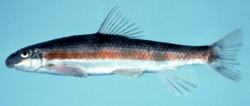Biology:Thoburnia rhothoeca
| Thoburnia rhothoeca | |
|---|---|

| |
| Scientific classification | |
| Domain: | Eukaryota |
| Kingdom: | Animalia |
| Phylum: | Chordata |
| Class: | Actinopterygii |
| Order: | Cypriniformes |
| Family: | Catostomidae |
| Genus: | Thoburnia |
| Species: | T. rhothoeca
|
| Binomial name | |
| Thoburnia rhothoeca (Thoburn, 1896 )
| |
| Synonyms | |
|
Catostomus rhothoecus Thoburn, 1896 | |
Thoburnia rhothoeca (common name torrent sucker) is a species of fish native to Virginia and West Virginia.[1]
Description
Thoburnia rhothoeca has a small mouth with lower lip edges that are nearly triangular.[2] The sucker has a small black skull and two air-bladders, although the air-bladders are reduced in size. The fish is small in size, and generally does not exceed seven inches. The fish exhibits sexual dimorphism, and its appearance varies depending on gender.[3]
The male sucker has a narrow red lateral band on it and a long dorsal and ventral fin. The female sucker has a narrow brown lateral band on it, and a shorter dorsal and ventral fin.[3]
Habitat
The habitat of the sucker extends from Northern Virginia to Eastern West Virginia. It is generally found in the James River and its discharges, although populations also exist in the Potomac River and its discharges.[1]
The fish is generally found in creeks and small rivers. It prefers clear waters with a rocky gradient and can live in waters with temperatures ranging from warm to cold. Younger Thoburnia rhothoeca can generally be found in smaller pools.[1]
Behavior
Thoburnia rhothoeca reach sexual maturity after one to two years of life. The sucker reproduces through spawning, which generally occurs from February to May. Female suckers lay an average of approximately 780 oocytes during spawning season with an average diameter of approximately two millimeters.[4]
The sucker is primarily a carnivore. Most of its diet consists of Chironomidae, although it will consume many other of species of insects when they are available. The sucker will also consume detritus.[4]
Conservation status
The sucker is ranked as least concern by the International Union for Conservation of Nature. Reasons for the rating include the stable population and the large range of the sucker.[1]
References
- ↑ 1.0 1.1 1.2 1.3 1.4 NatureServe (2013). "Thoburnia rhothoeca". IUCN Red List of Threatened Species 2013: e.T202374A18236520. doi:10.2305/IUCN.UK.2013-1.RLTS.T202374A18236520.en. https://www.iucnredlist.org/species/202374/18236520. Retrieved 12 November 2021.
- ↑ Page, Lawrence; Burr, Brooks (2011). Peterson Field Guide to Freshwater Fishes of North America North of Mexico. Houghton Mifflin Harcourt. ISBN 978-0547242064. https://books.google.com/books?id=rFTqmdDqn-wC&q=Thoburnia+rhothoeca&pg=PT274.
- ↑ 3.0 3.1 Raney, Edward; Lachner, Earnest (1902). Zoology Reprints and Separata, Etc, Volume 142. p. 675. https://books.google.com/books?id=aspJAAAAYAAJ&q=Thoburnia+rhothoeca&pg=PA132-IA89.
- ↑ 4.0 4.1 Tarasidis, Alexandra; Powers, Steven (March 2014). "Life-history aspects of Thoburnia rhothoeca (torrent sucker) in southwestern Virginia". Northeastern Naturalist 21 (1): 108–118. doi:10.1656/045.021.0109. http://www.bioone.org/doi/abs/10.1656/045.021.0109. Retrieved 3 April 2015.
Wikidata ☰ Q5533006 entry
 |


